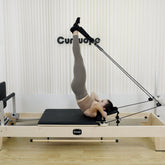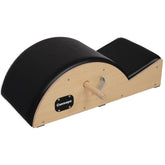Can Pilates Reformer help with sciatica?
Pilates Reformer can be a helpful tool for managing sciatica, which is a condition characterized by pain that radiates along the sciatic nerve, which runs from the lower back through the hips, buttocks, and legs. Here are some ways that Pilates Reformer exercises can help with sciatica:

Core strength: Pilates Reformer exercises focus on strengthening the core muscles, which can help improve posture and alleviate pressure on the lower back. When the core is strong, it can better support the spine and prevent compression of the sciatic nerve.
Spinal mobility: Pilates Reformer exercises can help improve spinal mobility and range of motion, which can also help alleviate pressure on the sciatic nerve. When the spine is flexible and mobile, it can better accommodate movements without causing compression or irritation of the nerve.
Hip mobility: Tightness in the hips can contribute to sciatic pain, so Pilates Reformer exercises that focus on hip mobility can be particularly helpful. By improving hip mobility, the sciatic nerve can move more freely without being compressed or irritated.
Stretching: Pilates Reformer exercises often incorporate stretching movements, which can help lengthen and release tight muscles that may be contributing to sciatic pain. Stretching can also help improve flexibility and mobility in the affected area.
Mind-body connection: Pilates Reformer exercises emphasize the mind-body connection, encouraging practitioners to focus on proper alignment, breathing, and body awareness. By cultivating this connection, individuals can learn to move more mindfully and avoid movements that exacerbate their sciatic pain.
It's important to note that Pilates Reformer should not be used as a replacement for medical treatment or advice, and individuals with sciatica should always consult with their healthcare provider before starting a new exercise program. A qualified Pilates instructor can work with individuals to modify exercises to their specific needs and ensure that movements are safe and effective.





